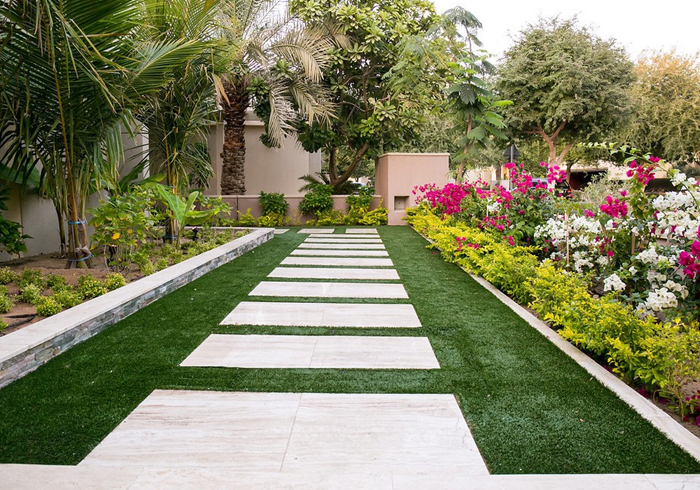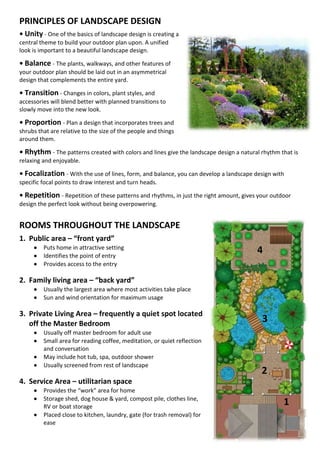The 15-Second Trick For Landscape Design
The 15-Second Trick For Landscape Design
Blog Article
7 Easy Facts About Landscape Design Explained
Table of ContentsOur Landscape Design IdeasLandscape Design - QuestionsExcitement About Landscape DesignNot known Factual Statements About Landscape Design
Official style theme. Credit Score: Gail Hansen, UF/IFAS The backyard is an extension of the home where a variety of activities occur. A yard can usually be split right into three locations: public (the front backyard), personal (the backyard), and service (commonly the side lawn). The area of task areas depends mostly on the sort of location, the dimension of space required, the sort of activity, and the preferred proximity to other tasks and frameworks (Landscape Design).
The outdoors wall of your house often functions as the first wall or starting point of an outside area. Incompatible uses need to be divided, and associated activities, such as food preparation and dining, need to be created to make the lawn more efficient and delightful. When making use of hardscape to produce rooms, use building and construction material similar to that used in your home for continuity from the residence right into the yard.
Linked rooms. Credit History: Gail Hansen, UF/IFAS Making use of comparable hardscape features and repeating plants draws the eye around the yard. Important points in the process can be highlighted with plantings or functions that draw interest and urge movement in a particular instructions. Relocating along the course takes a person from one location to the next and enables the individual to have a range of experiences.
This supplies a sense of secret that advertises exploration and discovery of the landscape. From a design viewpoint, plant products have 3 significant functions in the landscape: aesthetic, architectural and practical. Cosmetically, plants create an aesthetically pleasurable atmosphere and structurally plants arrange and specify rooms. Plants are practical due to the fact that they can transform the atmosphere for the convenience of the individual by changing light, temperature level and humidity.
What Does Landscape Design Mean?
For psychological convenience plants are utilized as physical or suggested barriers for privacy and security. Physical obstacles obstruct both the sight and access to an area and include fencings, walls and plant hedges.
Physical and suggested obstacles. Credit History: Gail Hansen, UF/IFAS For these reasons, the kinds of plants to be made use of (such as trees, hedges, or groundcovers) should be selected in the beginning of planning. Plant kinds are picked for their practical capacities so that their future objective and required room can be taken into consideration at the same time.
The above airplane, the upright airplane and the ground plane need to all be thought about to develop enclosure. When the shape of a plant bed has actually been established, the plants should be massed (organized) and split to attain aesthetic unity and the wanted quantity of room. The size of a plant mass will depend upon the total size of the backyard, the size of the private plants in the mass, and the emphasis or impact wanted from the plant product.
Each plant mass is in front of, behind, or next to, another mass. Figure 11. Horizontal plant layers. Credit Scores: Gail Hansen, UF/IFAS Figure 12. Upright plant layers. Credit Rating: Gail Hansen, UF/IFAS Repeating plants within a mass and repeating masses with similar plants connects the yard with each other. The individual plant features must be thought about to efficiently layer and mass plants.
The Best Strategy To Use For Landscape Design
All plant structures start with the main framework plants, the big, primarily evergreen background plants-such as the trees and big hedges. These plants different or enframe areas, manage the size of the space, view publisher site and supply the starting factor for picking the proper characteristics of the 2nd layer, midground plants, for massing and infill.
Vital points in the garden ought to be highlighted by the use special plants, distinctive frameworks, or yard ornaments. Marking limits or entries to areas can be done with entrances, arbors, and actions, or through using unique and colorful plants. The type and/or design motif of the garden will commonly aid determine the vital points and how they must be highlighted.
Other essential locations in the yard are centerpieces, which is made use of to aesthetically organize a landscaped location. The kind of centerpiece typically relies on the seeing perspective. Various viewpoints or perspectives can expose different make-ups in the landscape that may call for a range of prime focus. Contrasting structure, shape, dimension and color will certainly capture and hold the eye.
More About Landscape Design
Figure 13. Plant kinds. Credit Score: Gail Hansen, UF/IFAS After form, structure is the following dominant function of a plant; rugged, medium and fine textures can be used for contrast and emphasis in the landscape. Kind and structure both trump shade in the yard for a lot of the year. During certain moved here seasons, color will be the most visible characteristic of the yard.


The positive aroma of plants, the noise of wind in the trees, the audio and texture of water, and the shades and textures of sculptures, pots and garden furnishings all contribute to the experience of the yard. One detail that is often neglected is the effect of light on the visual appeals of the plants.
The whole yard changes in function and appearance over the program of the day, and the course of a year, as the light and temperature adjustment from early morning to night and period to season. Plant option need to consider a plant's growth rate, its mature dimension and kind, and the maintenance it will click to investigate need.
It is important to know the eventual fully grown size of plants so they can be positioned in the right place and spaced appropriately when they are set up. Providing plants room to expand is a difficulty since the typical mature size is typically based on optimal expanding conditions and the environmental conditions of a site might cause a plant to enlarge or stay smaller sized.
Report this page